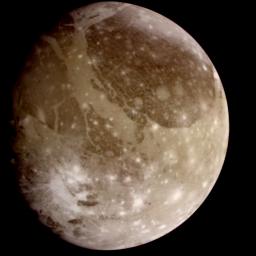
Contact: Mary Beth Murrill
July 10, 1996
"These images have exceeded our wildest expectations," said Dr. Michael Belton, of the National Optical Astronomy Observatories, who heads Galileo's imaging team.
At the same time, scientists studying data from space physics instruments on the spacecraft have made the major discovery that planet-size Ganymede possesses its own magnetosphere -- a bubble-shaped region of charged particles that surrounds many of the planets but has never been found to exist around a moon. The finding indicates that Ganymede, which is three-quarters the size of Mars, very likely creates its own magnetic field. Possible sources of a magnetic field include a molten iron core or even a thin layer of conducting salty water underneath its icy crust.
"What we've found is a magnetosphere within a magnetosphere," said Galileo Project Scientist Dr. Torrence V. Johnson at NASA's Jet Propulsion Laboratory, Pasadena, Calif. "While we expected some degree of interaction between Ganymede and Jupiter's magnetic environment, the size and the effect at Ganymede was completely unexpected," he said.
The crisp new images and magnetospheric findings were revealed in data returned by Galileo in the days since its first flyby of Ganymede on June 27, when the spacecraft came within just 835 kilometers (519 miles) of the big moon. Ganymede is the largest moon in the solar system. It is made of about equal proportions of rock and water ice. It is one of Jupiter's four large satellites that will be repeatedly visited by the Galileo spacecraft over the course of its two-year mission in orbit around the giant planet. Galileo entered orbit around Jupiter on December 7 last year. The spacecraft was launched from Earth on October 18, 1989.
The discoveries announced today are based on just a small portion of the data gathered and returned from the Ganymede flyby and mark the start of a steady stream of images and other information to be returned from Galileo over the next 18 months. The data were returned using new software radioed to the spacecraft earlier this year that allows Galileo to send back its scientific findings in shorthand form. This helps compensate for the loss of the use of Galileo's high-gain antenna and allows Galileo to return its findings via the smaller low-gain antenna also on the spacecraft.
These first images show two of the regions selected for close photographic study on Galileo's first pass of Ganymede yielded surprising new information about its geological past. The areas, called Galileo Regio and Uruk Sulcus, show ancient cratered ice fields adjacent to or overlain by younger ice volcanic plains, ridged ice mountains, deep furrows and smooth broad basins that are products of tectonic forces. About half of Ganymede's older cratered surface appears to have been resurfaced by younger volcanic and tectonic activity.
"These images reveal fundamental details about how features seen by Voyager formed and show us age relationships and sequences that turn our previous thinking upside down," said imaging team member Dr. James Head of Brown University.
The discovery of Ganymede's magnetosphere was made by space physicists using data from Galileo's plasma wave spectrometer, which measures variations in electromagnetic waves in Jupiter's environment and from the magnetometer, which measures the strength and direction of magnetic fields. Both instruments were sending data to Earth during the Ganymede flyby while recording even more detailed information to be returned later this month.
The plasma wave spectrometer also showed that the densities of charged particles around Ganymede increased by a factor of more than 100 near Galileo's closest approach, "This indicates that Ganymede is surrounded by a thin ionosphere," said Dr. Donald A. Gurnett of the University of Iowa and principal investigator on the plasma wave spectrometer experiment. "The existence of an ionosphere suggests that Ganymede also probably has a tenuous atmosphere," he said.
As the spacecraft approached Ganymede, the magnetometer found the measured field was as expected at that position in Jupiter's powerful field -- fairly uniform and pointed in a southerly direction. But as the spacecraft crossed into the region where the plasma wave spectrometer sensed signals characteristic of a magnetosphere, the field increased in strength by a factor of nearly five and abruptly changed direction to "point" at Ganymede itself, said Dr. Margaret Kivelson of UCLA, principal investigator of the magnetometer experiment.
Taken together, these two measurements strongly suggest that Ganymede is the first known moon with its own magnetosphere and the first example ever seen of a "magnetosphere within a magnetosphere."
"We knew Ganymede was an interesting place," said Johnson. "What we have just found makes it even more exciting."
The new discoveries will be quickly followed up by other data to being returned by the spacecraft this summer. All the experiments on Galileo that measure magnetic fields and particles recorded detailed data during the close approach and these data will be played back from the tape recorder in the next two months. "With all the data in hand, we will gain better insight into what is causing the strange environment around this moon," said Johnson. The Galileo science and engineering teams are planning three more close flybys of Ganymede over the next 18 months, which will take the spacecraft to different regions of the big moon's magnetosphere and allow close study of other regions of its surface.
The Galileo mission is managed by JPL.